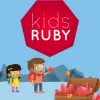Take a look inside 5 images
Kids Ruby
Pros: A well-written explanation of how programming works can help kids develop critical-thinking skills and better understand the logic behind how web pages are structured.
Cons: The navigation and structure aren't very intuitive, information isn't always easy to understand, and some activities are likely to confuse kids.
Bottom Line: KidsRuby offers some very general programming guidance, and kids can test out the examples -- but they'll need to do additional research before building much on their own.
Teachers may be able to use the KidsRuby basic programming section as a reading assignment. It explains how programming works in conversational, kid-friendly language and makes comparisons to real-world situations to help kids understand. (Kids are told to imagine they're giving design directions to a turtle, and thus learn how to draw shapes.)
The section on basic Ruby programming language, however, isn't really as helpful. Kids get some basic instruction on a few topics, including how to write Ruby code for short sentences, program basic math equations, and set up simple question-and-answer responses. Teachers can create a hands-on learning experience by letting kids key in and test the simple example scripts in the text as they follow along. But additional work may be required to clarify certain terms and concepts that are introduced but not fully explained (or explained clearly), like the difference between using Fixnum and String objects.
KidsRuby pledges to make it "fun and easy to learn how to program," but the application's biggest benefit is its overview of how programming works. The main page has three tabbed sections. The Help tab offers background and instructional information. Some was adapted from the programming tutorial site Hackety Hack, which was the inspiration for KidsRuby; some can be a little confusing. The left side of the screen prompts kids to enter code on the first page they're taken to -- before they’re really told how to do it. The main menu lists seven sections. One requires a supported hardware device, and two others, which involve games, are difficult to use if kids haven't already mastered the Ruby programming language basics.
It's doubtful that the section's basic Ruby instructions would prepare kids to use the application's game design instruction. It's also difficult on a Mac OS to get past the first step on a game that's supposed to offer coding practice. (During a recent attempt, Ruby Warrior alternately restarted or offered a blank screen, and repeatedly posted a notification that the user wasn't taking action.)
Younger kids likely will need help from a teacher or parent to understand and replicate some of KidsRuby's instruction, and students don't necessarily learn how to create their own sites, with or without the KidsRuby platform. Teaching kids basic HTML would probably be easier (and possibly more effective). Providing a basic code cheat sheet to help kids plug items into a simple web page would give them a chance to develop the same strategy, tech, and critical-thinking skills.











